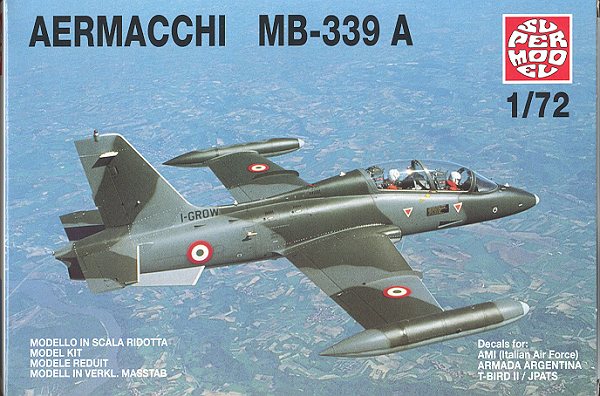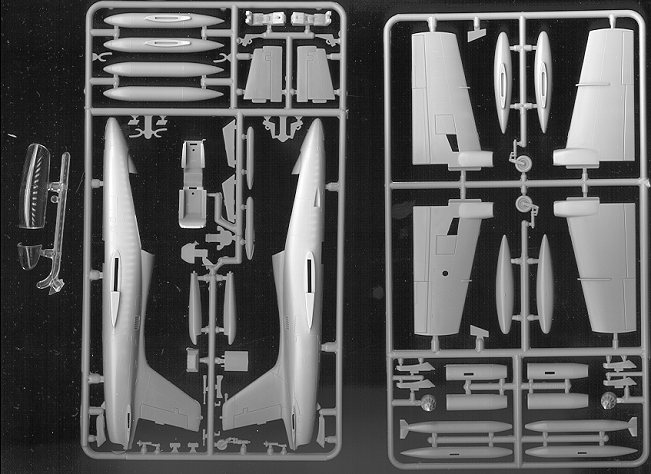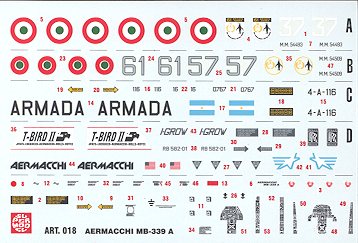
| KIT: | Supermodel 1/72 MB.339A |
| KIT # | 10-018 |
| PRICE: | $10 |
| DECALS: | See Review |
| REVIEW & | |
| NOTES: |

| HISTORY |
The Aermacchi MB.339 is a vastly improved version ofthe earlier MB.326 advanced trainer. Starting in the mid 1970s a replacement forthe older MB.326 was sought. The requirements were that it retain most of thepositive features of the older MB.326, while allowing for improvements over someof the less desirable qualities of the older aircraft.
What emerged was an aircraft that looked very much like theolder version. In fact, the biggest change was in the nose section which wasmore sharply raked so that the instructor pilot could be seated higher than thestudent. Most of the rest of the aircraft was very much the same as the earlierversion.
The improved MB.339 first flew in 1976 and quickly took over thetraining duties of the MB.326. These 'extra' airframes were then farmed out tovarious units to be used as 'hacks' until finally retired in the mid-1990s. TheMB.339 was one of the competitors in the JPATS competition for a new USAF/USNtrainer. For this, Aermacchi teamed with Lockheed and touted the aircraft as the'T-bird II'. The competition was won by the Pilatus PC-9 turboprop.
| THE KIT |

Supermodel'skit of the 339 is actually a pretty new kit, hitting the market in the early1990s. It comes in one of those end-opening boxes that most of us hate as itgives no where to put your kit while it is being built. Made of the usual lightgrey plastic, the kit is free from any flash. However, there are a number ofsinkholes, some of them which will be nearly impossible to fill without damagingthe detail. The biggest ones are on the headrest of the ejector seats. There areothers scattered throughout the kit and they are where there is an alignment pinor slot.
A very unusual feature for such a new mold isthat most of the detailing is of the raised line variety. Quite odd in a newkit, though keeping with the rest of the Supermodel line. Kit options are openor closed speedbrake, open or closed canopy and two types of wing tip tanks. Theunderwing stores include fuel tanks and rocket pods. The location for theunderwing pylons are raised locator lines; the parts being butt fitted. In factthis is true of the tip tanks as well despite there being a slot in the tanks.
Thelanding gear have the wheels molded as part of the gear, either for strength orsimplicity of molding. It is obvious from the way the two sprues are setup that the wings, gear and underwing stores are common to both this and theMB.326 kits. The cockpits are well appointed with seats and sticks. Theinstruments and consoles are provided with a decal, which is satisfactory forkits in this scale.
 The instruction sheet is an eight page foldout with the usualhistory and warnings. One side of it shows the construction sequence and partslayout with a couple of photos to aid in construction. The other side is thehistory and decal/color chart. Four aircraft are featured on the sheet, which ismatte and slightly off register. I also believe the blue is a bit questionable.The four options are: one with the Scuola Volo Basico Iniziale Aviogetti or SVfor short in the early camo scheme. Next is one with 61 Brigata Aerea in the newgrey. An Argentine Navy version is next and finally a demonstrator for the JPATScompetition in an experimental grey scheme rounds out the selection.
The instruction sheet is an eight page foldout with the usualhistory and warnings. One side of it shows the construction sequence and partslayout with a couple of photos to aid in construction. The other side is thehistory and decal/color chart. Four aircraft are featured on the sheet, which ismatte and slightly off register. I also believe the blue is a bit questionable.The four options are: one with the Scuola Volo Basico Iniziale Aviogetti or SVfor short in the early camo scheme. Next is one with 61 Brigata Aerea in the newgrey. An Argentine Navy version is next and finally a demonstrator for the JPATScompetition in an experimental grey scheme rounds out the selection.
Overall,it does not look like a difficult kit to build. I am slightly disappointed by itnot having engraved panel lines and the sink marks, but it should not detracttoo much from the overall product.
Review copy courtesy of me and my wallet!
If you would like your product reviewed fairly and fairly quickly by asite that has over 900 visits a day, please contactme or see other details in the